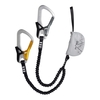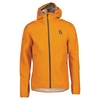Quo Vadis, new route by Tondini and Irsara on Sass dla Crusc, Dolomites

 1 / 19
1 / 19 Paola Finali
Paola Finali
After Menhir, Nicola Tondini and Ingo Irsara have also established Quo Vadis. Two new routes, both climbed in 2010, up the magnificent West Face of Sass dla Crusc... If this isn't a small obsessive love affair, it's certainly something remarkably similar... So much so that Tondini had already established La Perla preziosa in 2008 with Zandegiacomo and Sartori, while three years earlier together with Adam Holzknecht he had carried out the first repeat and first winter ascent of "Loss lei, heb schun", the route established by Helmut Gargitter and Renato Botte in 2003.
This latest creation, Quo Vadis, climbs the large yellow lower wall and touches on the left-hand side of the immense roof which marks the right-hand pillar, and then winds its way up the compact wall between the "Mutschlechner-Grossrubatscher Memorial Route" (Cristoph Hainz & Andrea Oberbacher, 1991/1994) and Jugendliebe (Othmar Zingerle & Michi Andresla, 1992). According to Tondini, Quo Vadis is "sufficiently distant" from these two great and difficult routes meaning that the new line is completely autonomous. The Italian mountain guides needed 8 days to climb the 470m line during which they attempted to use a minimum number of bolts and climb as much trad as possible. "Of the 14 demanding obligatory sections (graded between 7a - 7b+)" Tondini explained "11 are protected by pegs and 3 by bolts. 2 of the 3 crux sections (7b/7b+ obl.) aren't protected by bolts." As the two first ascentionists underline, a complete redpoint ascent has been postponed to next season and the precise difficulties still need to be defined properly. In the meantime though Quo Vadis, as can be gleamed from their report, photos and videos, represented a tough challenge.
QUO VADIS by Ingo Irsara
What can be said about these two new routes? Menhir and Quo Vadis are two entirely different worlds. Menhir isn't banal by any means, even if it's only 5 pitches long. But compared to Quo Vadis it seems like a walk in the path. Menhir is a small work of art, established in two days offering technical and sustained climbing which could become a classic up this face. Quo Vadis, despite being one of the most obvious lines on Sass dla Crusc, has all the hallmarks of becoming even harder still. The first ascent turned out to be a true and proper adventure and I often asked myself just what I was doing half-way up this face. Almost constantly overhanging and airy, the advantage here is that if you drop something - like Nicola's shoe at the start of the third ultimate pitch - then it falls straight down to the start, without ever bouncing off the wall. In short, Quo Vadis really tested us both physically and psychologically. I've repeated almost all the difficult routes on this face (apart from the classic ones, also the recent additions Jungendliebe [Zingerle/Andres, 1992: VIII], Auf die Felsen, ihr Affen first winter ascent [Hainz/Astner, 1994: VIII], Silberschrei first repeat [Auer/Schrieber, 2005: IX], La Perla Preziosa [Tondini, Zandegiacomo, Sartori, 2008: IX]), but this is certainly the hardest. I can't wait to try the redpoint next year. It'll certainly be another great adventure, to be savoured once again.
Ingo Irsara
SASS DLA CRUSC ONCE AGAIN! by Nicola Tondini
Quo Vadis? Where are you heading? I was often asked this question this summer. To Sass dla Crusc I almost always replied. It seems as if I was always up there during this Dolomite season... and in fact I pretty much was. Ingo and I spent 11 long days spread out between July and October climbing up and down that mountain face. Just 4 days after having completed Menhir on Pilastro di Mezzo (200m, 7b+), Ingo and I were once again at the base of the massive limestone wall which dominates Val Badia. We wanted to establish a new route up one of the most obvious lines on the wall, the one which reaches the left-hand end of the enormous roof on the yellow face. When you start any of the classic routes on Sass dla Crusc you're attracted to the 7 drawn by that enormous roof, which then loses itself in the overhangs and compact walls above.
Between 1991 and 1994 Christoph Hainz, together with Andrea Oberbacher, established the hardest route of his career on this face - not only thanks to its grade IX-/IX technical difficulties, but also due the demanding psychological nature of the climb. It comes as no surprise therefore that the route was repeated for the first time as late as 2009 by Simon Gietl after 5 days of attempts. Established without bolts, the route takes a line up the right-hand side of the large roof and then continues up the extremely difficult compact wall, past slender cracks to a large ledge. Via a series of cracks and corners the two mountain guides reached another compact dark limestone slab, which was to become the crux of the entire route: difficult and psychologically demanding, it cost the strong South Tyrolean alpinist a long fall and a broken arm.
The first pitch of our route climbed the open face and then, to avoid a friable ramp, it follows corners and cracks which in two pitches led to the left-hand margin of the immense roof. A long airy traverse leftwards enabled us to overcome the roof and reach the ledge at mid-height, past compact grey slabs and tiny corners. Where should we go next? This is what Ingo and I continued to ask ourselves during our attempts on this upper section above the large edge. While the line was fairly obvious below, inventing one up here proved extremely tricky. We climbed between Hainz's route and Jugendliebe and kept a sufficient distant from both of them. There wasn't even the shadow of a crack on that slab, only compact limestone, broken every now and then by horizontal breaks. We slowly understood that the line we'd take would be via the only series of feasible holds on offer on this portion of the wall.
We needed a total of 8 days to complete this ascent and managed to ascend the first 9 pitches placing just 3 bolts for the belays (apart from one placed at the end of the 8th pitch in a failed attempt to forge a direct line). At the height of the black squiggle on Hainz's route we were forced to place some bolts, and on the 10th pitch I managed to climb the first 30m with some pegs and a couple of friends, but then on the long run-out section (at least 12m, with the certainty of hitting the slab in a 20 -30m fall) we placed 3 spaced bolts before reaching another horizontal crack. On the next pitch I managed to climb the crux protected by pegs, and after this particularly difficult section I then reached a discreet edge. I looked around: I was 5-6 meters above my last pro and everything around me was smooth. My forearms warned me I was beginning to get pumped. I stopped and weighted a cliff hanger which I placed on the small edge I'd been holding. I attempted to drive a peg in some of the small pockets, but they were all blind, the pegs entered no more than 2mm. In the meantime my forearms began to feel better. Had I wanted to, I could have continued, but this isn't my style, it wouldn't have been fair for those wishing to repeat the route. So I placed a bolt and then continued up easier terrain. On the last pitch I encountered a similar situation: I managed to free all the crux moves (after a series of falls on trad gear), but then placed 2 bolts on easier but unprotectable terrain. In total there are 7 bolts along the route and 8 on the belays. I can't give a precise grade about the difficulties, but it's definitely somewhere in the region of 7b/7b+ obligatory and 8a/8a+ max. I'd only ever taken as many falls as here during first ascents on my routes in Val d'Adige. The final result is 14 demanding obligatory sections (7a - 7b+ obl) which characterise this route and often resulted in me taking falls. 11 of these are protected by pegs and 3 by bolts. Despite not being completely trad, the route maintains much of these characteristics. 2 of the 3 crux sections (7b/7b+ obl.) are not protected by bolts.
These are the numbers of the route, but the emotions it gave me were far, far greater. The days were almost always full-on (from 06:30/7:00 am to 21:00/22:00) spent on this panoramic balcony, one of the most beautiful in the Dolomites. Most attempts were accompanied by the cold and wind, as well as splendid sunsets which remain indelibly impressed in my mind, stunned by the sheer beauty of it all. Then there were the same paths we walked on which changed throughout the seasons, with warm autumn colours accompanying our final days. And then there was the last day. Perhaps the most beautiful of all, with a thick layer of clouds lingering at 2600m and making us feel as if we were climbing high in the sky, well above the clouds. Once on the summit we couldn't help but enjoy this marvellous spectacle for half an hour before descending. This was a magnificent coronation of our journey in which the question "where next" marked our days, just as it often marks our lives. Where next? Where can one find that peace and joy which we yearn for so dearly? What is certain is that when we stop and manage to contemplate about what surrounds us, then we allow our soul to elevate and find a bit of that yearned-for peace.
Nicola Tondini
Sass dla Crusc, West Face
New route: "Quo Vadis?"
Nicola Tondini, Ingo Irsara
30 July 2010; 4-7-21 August; 11-23 September; 7-8 October 2010
Length: 470m, 13 pitches
Gear: 61 in-situ pieces of gear: 54 pegs, nine of which backed up, and 7 bolts.
17 pegs and 8 bolts on the belays
Nuts, Tricam, Friends Camelot/BD (0.3-0.4-3x0.5-2x0.75-2x1.0-2.0-3.0-4.0), Alien.
For the route topo and grade will have to wait for the redpoint which has been postponed to next season.
Nicola: an important thanks to MARMOT, WILD CLIMB, FERRINO and the shop TURNOVERSPORT for the excellent gear.
Ingo: an important thanks to the shop VERTICAL SPORT.
The photos and film made during the ascent are part of a evening show elaborated by Andrea Tosi and Paola Finali during which Nicola Tondini gives a sweeping view of his vertical activity. In particular, this concentrates on Tondini's "trad" first ascents in the Dolomites, his hard ground-up sport route first ascents and important repeats (such as the Messner route on Pilastro di Mezzo del Sass dla Crusc and the famous section on the "Messner slab").
| Links Planetmountain | |
| La Perla preziosa - Sass dla Crusc | |
| Menhir - Sass dla Crusc | |
| News Nicola Tondini | |
| Links www | |
| www.xmountain.it | |
| Expo.Planetmountain | |
| Expo Ferrino | |



 Copia link
Copia link



















 See all photos
See all photos






















